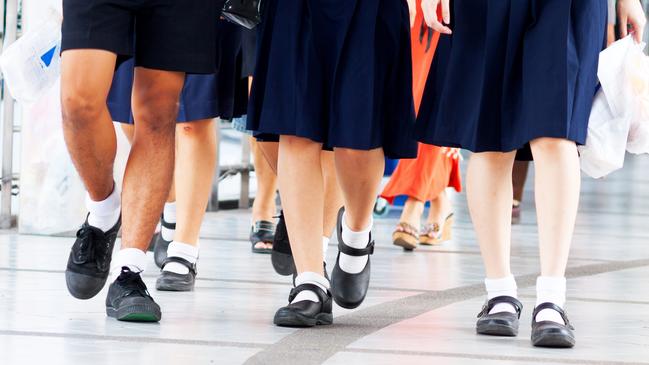Rising costs of school uniforms sparks new debate
Experts are warning school uniforms can create “social cliques” and reinforce gender stereotypes, as debate erupts over whether they should remain compulsory amid a rising cost of living.
Education
Don't miss out on the headlines from Education. Followed categories will be added to My News.
Uniforms are expensive, can create “social cliques” in schools and reinforce gender stereotypes, experts warn, as debate erupts over whether mandatory uniforms should remain compulsory in Victoria.
Former school principal and now senior lecturer in educational leadership at Australian Catholic University, Dr Paul Kidson, said some people believe uniforms are an outdated part of the education system.
“Many uniforms from independent schools are generated out of a history, culture and time that some think are no longer applicable,” he said.
“A lot of boys’ schools still have that strong blazer suit style that developed in cold England.”
Dr Kidson said many people believe girls shouldn’t be forced into dresses, and should always have the option to wear pants and shorts, particularly for sport.
It became compulsory for government schools to offer shorts and pants for girls in 2018, while it remains a choice for independent schools.
Parents in Victoria were tipped to spend on average $1285 on back-to-school supplies this year – an increase of 36 per cent more from 2023. Figures from Officeworks revealed Victorians were forced to cough up the most across the country for uniforms, with an average price of $260.
Blazers at some of Melbourne’s most expensive schools, including Mount Scopus and Haileybury, are $245 alone.
With students sent home for not wearing uniforms correctly, Parents Victoria chief executive Gail McHardy said education should be about what was being taught in the classroom above all else.
“We all need to focus on the importance of learning, not what we are wearing, school uniform or not,” she said.
The Herald Sun revealed last year female Mentone Grammar students were pulled out of class to have their school dress lengths measured, with those whose dresses were deemed to be too short sent home.
Rising uniform costs are also adding pressure to household budgets, with some parents forced to seek help from grandparents, friends and support agencies to cover yearly uniform costs.
“Every child has the right to access a public education without any additional challenges due to their family’s socio economic status,” Ms Hardy added.
“School uniforms can be expensive and we urge schools to ensure any changes to their policies or uniform items do not price out families which can inhibit student attendance.”
Professor Nicole Rinehart, director of the Krongold Clinic at Monash University, said for the one in five children who had a developmental challenge or disability, challenges with uniforms could lead to school refusal and poorer educational outcomes.
“I can’t think of an autistic child that hasn’t had an issue with uniforms. Whether it’s getting changed into their sport uniform in front of people, switching from one uniform to another, or the actual uniform sensory elements,” she said.
“If a student has a disability and can’t bend down to tie their shoelaces, it can be a humiliating experience.”

She said schools needed to be more flexible and provide options for neurodivergent students.
“For autistic children, it could be the seam on the school socks they can’t tolerate. The solution could be finding another pair of socks that look similar and feel better from Target or Kmart.” she said.
“One child can wear a uniform and feel a sense of belonging and pride and another child could be suffering in silence all day because of it.”
Dr Kidson said many teachers took the view that uniforms are beneficial for safety.
“You have a high responsibility as a teacher for student safety, particularly while on excursions. It helps when you have 25 shirts in all the same colour if you need to do a quick headcount,” he said.
RMIT University Professor Ange Fitzgerald said uniforms can “create a shared culture of belonging and connections”.
“A uniform doesn’t take the place of how a student presents and expresses themselves. The hope is that the school environment still encourages and provides avenues for expression of identity and a range of perspectives in safe and support ways,” she said.

Dr Kidson said some private school students had figured out how to adopt a sense of identity by pinning badges and ribbons to their blazers, but this could create other issues.
“But then it’s a question of those that are left out,” he said.
“It becomes a social clique on how many badges you have. It’s saying this is what’s symbolically important. Spare a thought for those kids that never get a badge or special blazer.”
Dr Kidson added that in any school – public or private – one of the most challenging days for a principal was a non-uniform day.
“There’s some parents that pay school fees out of pocket money and others that have to work five jobs to afford for that kid to be in a school.
“Having to deal with kids talking about what people are wearing – it creates social angst and time is taken away from learning.”
Professor Rinehart said she had seen many children who had been bullied, excluded or shamed because they didn’t have the material resources to “keep up” with other kids.





